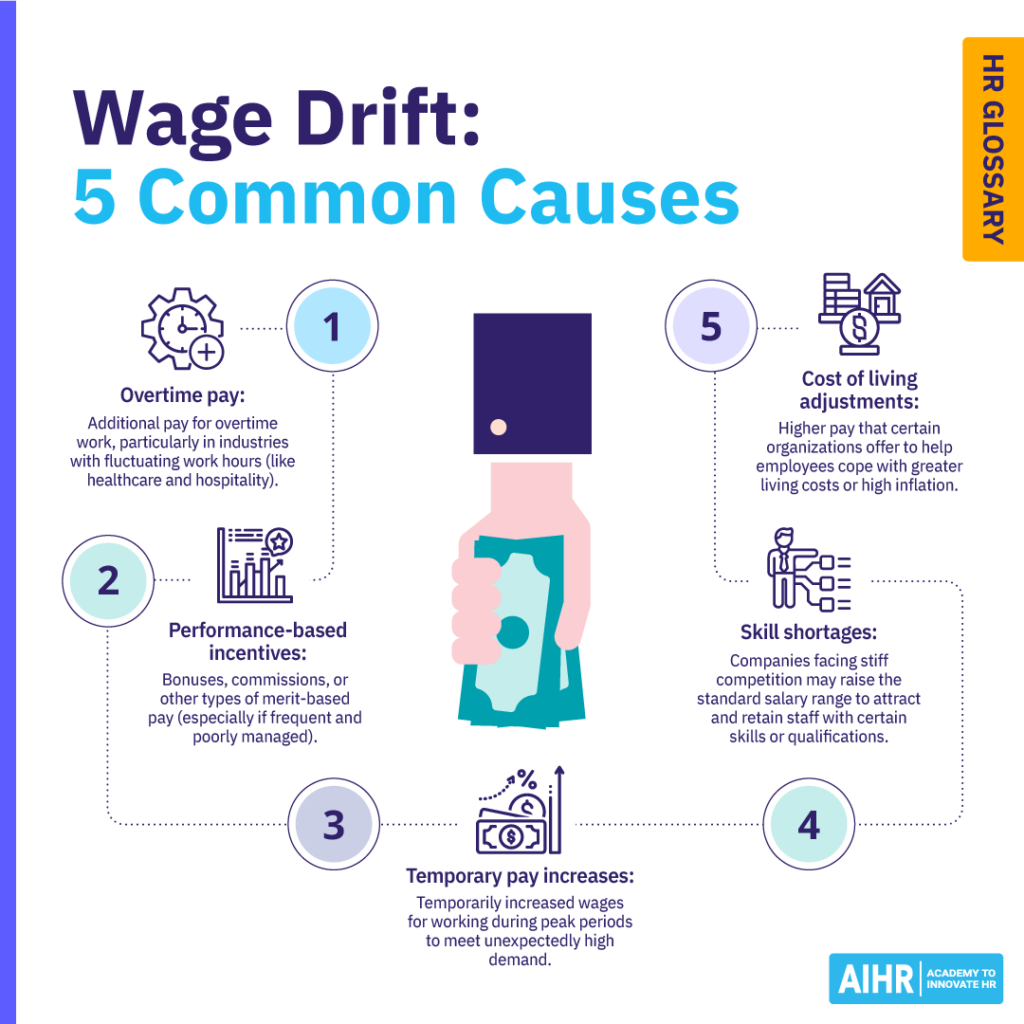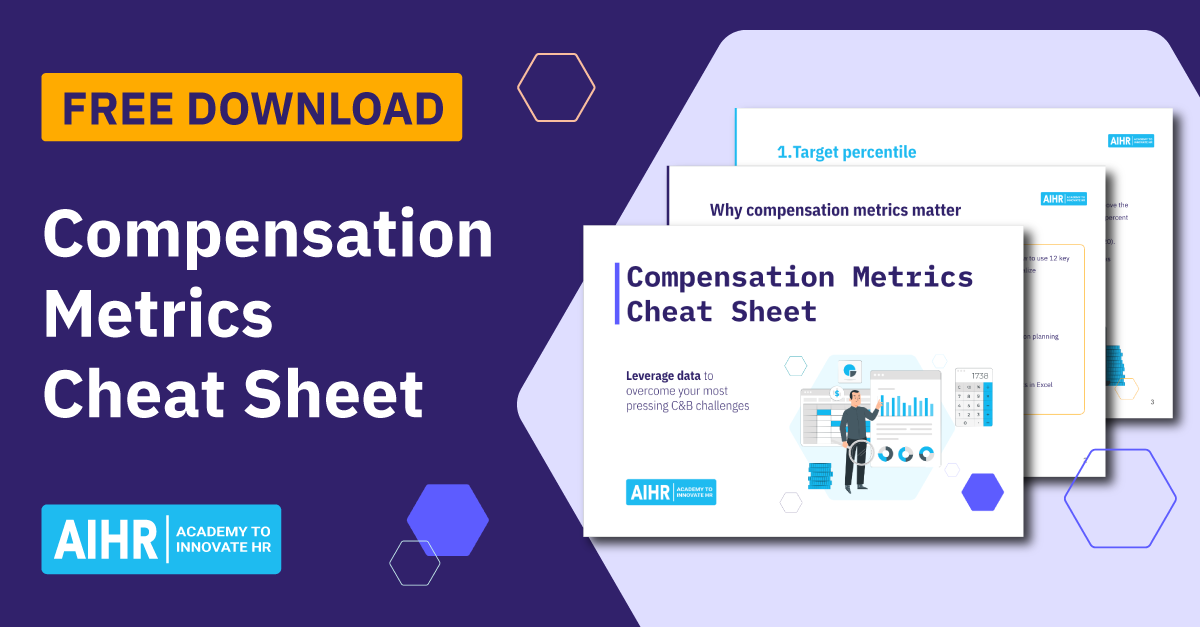Wage Drift
What is wage drift?
Wage drift refers to the difference between the base wages agreed upon in a collective bargaining agreement (or any standardized wage structure) and the actual earnings of employees.
It typically occurs when an employee receives extra pay from overtime pay, bonuses, shift differentials, or other forms of compensation beyond their base pay.
An example of wage drift is a customer service employee who earns $55,000 per year as stipulated in the company’s wage structure. During a busy quarter, they work several weekends and receive an extra $5,500 in bonuses, shift differentials, and overtime pay. This brings their total earnings for the year to $60,500, exceeding the initially agreed-upon base salary and illustrating wage drift.
HR professionals must closely monitor wage drift to avoid increased payroll expenses, pay inequality, and tax compliance issues.
Calculating wage drift
To calculate wage drift, use the formula:
Wage Drift = Actual earnings – Base wage
Actual Earnings is the total amount the employee earned, including overtime, bonuses, or additional pay. Base Wage is the agreed-upon or standardized wage according to their employment contract or collective bargaining agreement.
So, the complete formula can be written as:
Wage Drift = (Base wage + Overtime pay + Bonuses + Additional pay) – Base wage
Here’s an example.
An employee’s base annual salary is $60,000. Throughout the year, they also receive:
- Overtime pay of $3,000
- Bonuses of $1,500
- Shift differentials of $500
Their Actual Earnings are calculated as:
Actual Earnings = $60,000 (Base wage) + $3,000 (Overtime pay) + $1,500 (Bonuses) + $500 (Shift differentials) = $65,000
Now, calculating the wage drift:
Wage Drift = $65,000 (Actual earnings) – $60,000 (Base wage) = $5,000
In this example, the wage drift is $5,000, which represents the total additional earnings beyond the base salary.
Understanding and managing wage drift in compensation planning
5 common causes of wage drift
Some of the most common causes of wage drift include:
- Overtime and extra hours: When employees work beyond their standard hours, the extra compensation they receive for it (often at a higher rate than that of their base pay) contributes to wage drift. This typically applies in industries with fluctuating work hours, like hospitality, healthcare, and construction.
- Bonuses and incentives: Bonuses, commission pay, or other types of merit-based pay can lead to wage drift, especially if they are frequent and poorly managed.
- Temporary pay increases: Employees who work during a company’s peak periods may receive a temporary wage increase. Unexpected or unplanned periods of high demand can significantly increase base wages or salaries.
- Market demands and skill shortages: In a competitive job market, organizations may need to raise the standard salary range to attract and retain employees with the required skills or qualifications.
- Cost of living adjustments: Companies may offer cost of living adjustments to help employees cope with increased living costs or high inflation, which could significantly increase established compensation levels.

Advantages and disadvantages of wage drift
Here are the pros and cons of wage drift for both employers and employees:
Advantages
- Increased job satisfaction: Receiving performance-based incentives or other financial rewards for their work can improve overall employee motivation and engagement.
- Fair compensation: Well-managed wage drift can ensure employees’ wages or salaries fairly match their performance, extra effort, or other contributions.
- Improved standard of living: Wage increases can give employees a better standard of living, especially amid rising inflation and higher living costs.
- Aid during peak periods: Managing high demand or peak periods can be difficult. Offering increased compensation, such as overtime pay, can help companies secure the workforce they need during busy business cycles.
- Better organizational agility: Offering wage or salary increases can allow organizations to respond more quickly to changing business needs.
Disadvantages
- Unpredictable costs: These additional pay elements can cause unexpected increases in payroll expenses, complicating businesses’ accurate budgeting.
- Difficulty managing pay equity: Wage drift varies across departments or individuals (due to overtime or incentives), leading to disparities that complicate pay equity and fair compensation efforts.
- Possible reliance on extra pay: Employees might begin to depend on the additional earnings as part of their regular income, leading to dissatisfaction if these extras aren’t consistently available.
- Risk of wage inflation: When wage drift becomes a norm in response to high demand or competition, it can push overall wage expectations up, which can be difficult to sustain long-term.
- HR administration complications: Managing these pay variations can make it challenging to maintain a consistent compensation structure, particularly with frequent or temporary adjustments.
How can HR implement effective wage drift management practices?
Wage drift must be closely monitored to prevent it from hurting an organization. HR can play a crucial role in managing these fluctuations by following these essential steps:
Step 1: Audit current compensation data
Begin by gathering comprehensive data on wages, including base pay, overtime, bonuses, and other compensation contributing to wage drift. You can then identify patterns by examining where actual wages deviate from agreed-upon salaries, such as overtime costs, additional allowances, and frequent bonuses.
From here, you can compare your company’s wages with industry standards to assess whether these deviations are unique to your organization, driven by external factors, or both.
Step 2: Define policies and guidelines
Based on the audit results, adjust your compensation policy to include clear guidelines and criteria for bonuses, overtime, and cost-of-living adjustments.
Once you’ve done this, share your compensation policy with all employees so they know how the company determines base salary and additional compensation. Be transparent about the organization’s wage drift limits.
Step 3: Closely monitor compensation levels
Closely monitor compensation changes by tracking metrics like average salary increases, overtime costs, bonus payouts, and other types of compensation that may cause wage drift. Next, group this data by department and function to identify any patterns in pay variations.
Further, explore the possible reasons behind wage drift in the identified areas, such as economic conditions, skill shortages, and internal pay equity issues.
Step 4: Make the necessary changes
Based on your compensation data analysis, make necessary adjustments to your compensation structure (e.g., modifying bonus policies or overtime rules). To make the approval process more efficient, ensure all compensation increase requests go through automated systems, which can track and flag any requests that exceed predetermined limits.
Next, train managers on any updates to your organization’s compensation policies, focusing on managing financial incentives and overtime in a way that minimizes unintended pay drift.
Step 5: Continuously review and adjust
Regularly evaluate how well updated compensation policies and approval processes have prevented wage drift and make any necessary adjustments to improve them. You should also stay on top of industry trends to ensure your compensation structure is attractive and competitive and identify where positive wage drift may be necessary.
Additionally, it’s crucial to get employee feedback on any changes to your compensation policy to ensure it meets their expectations, so you can help maintain morale while minimizing wage drift.
HR tip
One effective way to manage wage drift is by offering non-monetary incentives. 65% of employees say they value recognition and praise more than financial rewards. Providing professional development opportunities, wellness benefits, and flexible work arrangements can also help reduce the need for extra monetary incentives.
FAQ
A cashier’s base pay is $580 per week ($14.50 per hour for 40 hours). In one week, they work an extra five hours at time-and-a-half ($21.75 per hour). For those extra hours, the cashier earns an additional $108.75 ($21.75 x 5), which increases their total earnings for the week beyond the standard base pay—creating wage drift.
To calculate wage drift, take the difference between the agreed-upon base wage and the employee’s total actual earnings, including any overtime, bonuses, or additional pay. This difference represents the drift amount.









